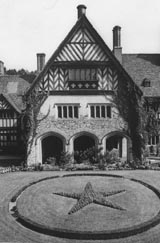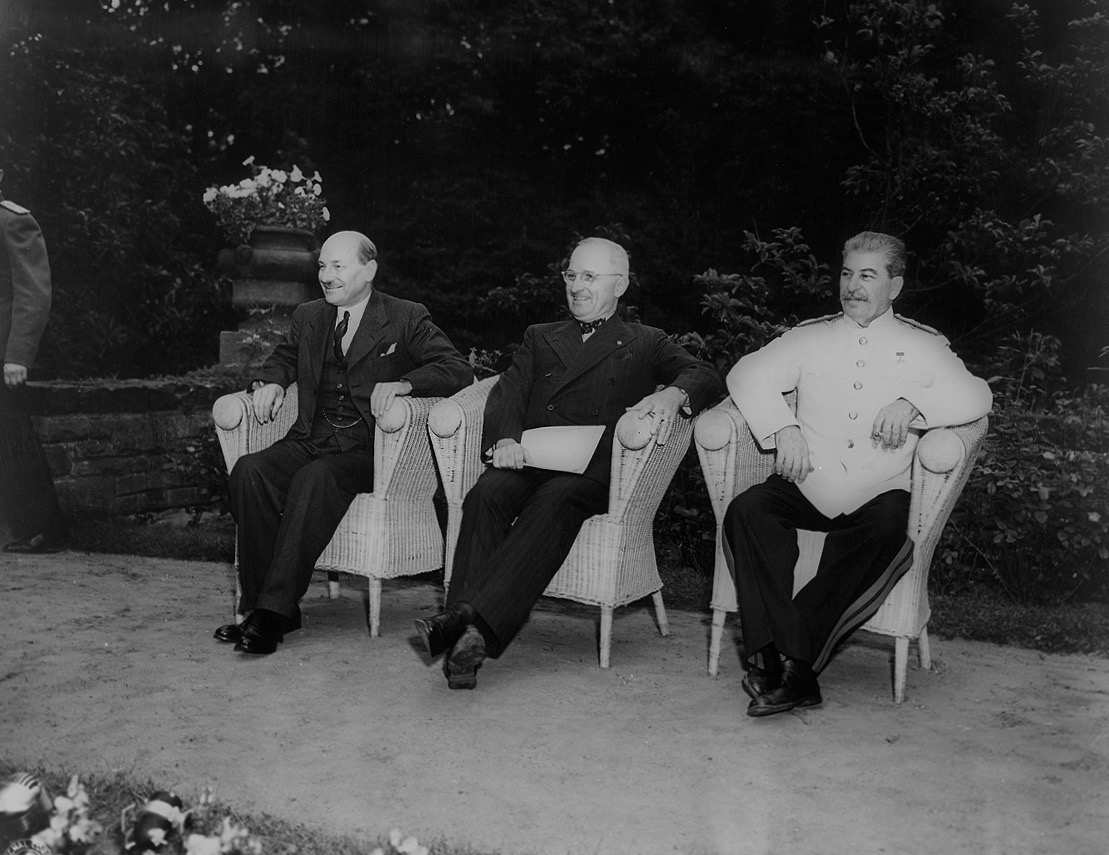On April 26, 1945, six days before Soviet troops finished taking what smoldering husks were left of Berlin, they captured Cecilienhof Palace in Potsdam, 17 miles to the southwest. Built during World War I by Kaiser Wilhelm II for Crown Prince Wilhelm, the 176-room Tudor-style manor, fronting luxuriant grounds and lakes, was completely intact—a small miracle amid the region’s devastation. Berlin was so reduced to rubble that Allied leaders abandoned plans to hold their triumphal summit there: it posed logistical and security nightmares. Potsdam, Prussia’s traditional second capital and today’s capital of the state of Brandenburg, was the logical fallback.
The two-week conference held there beginning on July 17 at Cecilienhof shaped the next half-century. Driving from their requisitioned mansions in nearby Babelsberg and skirting Potsdam’s central ruins, the Big Three—Harry S. Truman, Winston Churchill, and Joseph Stalin—must have thought it slightly surreal to step into this oddly English relic, the last palace built by Germany’s final ruler from the Hohenzollern dynasty, who was also Queen Victoria’s first grandchild.
For the Allies convening after FDR’s recent death, much was in flux. Churchill attended the conference with Clement Attlee, the Labour Party leader who was Deputy Prime Minister in Churchill’s wartime coalition government; when the results of a general election in Britain were announced on July 26 and Churchill was resoundingly voted out of office, Attlee took over. A famous photo captures the summit’s revamped trio on the rear veranda facing Heiliger See (Sacred Lake). Thirty years later, when I was last here, the Berlin Wall blocked the view. On a fine spring day last year, I found the wall had been transformed into a bicycle and footpath. I followed it and others around the lake and gardens, reflecting on historical ironies surrounding me, where Hitler’s war ended and the Cold War began.
In the 10th century, the region was known as Poztupimi and consisted of three Slavic villages built around a castle. The name means “beneath the oaks,” and plague, fire, and war kept it rustic for centuries. Then, in 1640, Frederick William, Elector of Brandenburg, took over and made the island town on the Havel River his second royal seat, after Berlin. Before he died in 1688, he set in motion its—and Germany’s—metamorphosis.
Brandenburg was the core of what Frederick William and his heirs expanded into stiff, militaristic Prussia. But Potsdam, like Berlin, bent the stereotype. In 1671, Frederick William welcomed 50 Jewish families expelled from Vienna; their taxable businesses helped fill his coffers. A staunch Calvinist, he offered religious tolerance to persecuted French Huguenots—with the same result. His heirs invited the Dutch, Bohemians, even Russians; ditto. The infusion of diversity helped transform Potsdam into a thriving city.
Arriving from Berlin on the S-Bahn railway, I walked from the station over the Havel’s oldest crossing to Alter Markt (Old Market Square). Here Frederick William built his Stadtschloss (City Palace); hit by Allied bombs, it was razed in 1961 by the Communists. The baroque Altes Rathaus (Old City Hall), topped with a distinctive circular tower and gilded statue of Atlas, is on the east. Several blocks north rises an oval 18th-century French Huguenot cathedral, by Dutch architect Jan Bouman, where Napoleon stabled his cavalry. Behind Bouman’s house runs the colorful Holländisches Viertel, a Dutch village he designed to be just like home.
A few minutes’ walk from Alter Markt is a temporary museum where a military chapel, the Garnisonkirche (Garrison Church), stood until the East German government demolished it. On March 21, 1933, it played host to what Germans call the Day of Potsdam: Chancellor Adolf Hitler met President Paul von Hindenburg, the Great War’s hero. Their fateful handshake sealed the devil’s bargain between Prussian militarism and Nazism, and yielded the Enabling Act, giving the führer dictatorial powers and unleashing the horrors to follow.
To the northwest sprawl the 700-plus acre grounds of Sanssouci Palace; its French name means “without care.” A day trip unto itself, the opulent park mimics ancient Rome with sculpture gardens, baths, and a church built to resemble the Basilica of San Clemente; its palaces evoke Versailles.
Here Frederick II entertained brainy pals like Voltaire along with his gambling and drinking army buddies. After his successful alliance with the British against the French, Austrians, and Russians in the Seven Years’ War, he erected the rococo Neues Palais (New Palace) on the western grounds to embody Prussia’s major-power status. And it is here he’s buried, next to his nine dogs.

On Potsdam’s northeast corner, Cecilienhof epitomizes luxurious Tudor Romanticism, although it was built when England was Germany’s mortal foe and money and materials were scarce. After it was completed in late 1917, Crown Princess Cecilie—Tsar Nicholas II’s second cousin—gave birth there; Crown Prince Wilhelm was commanding a Western Front army and pushing to end the war before Germany lost. A year later, the November revolution forced the abdication of his father, the Kaiser; Wilhelm fled to Holland and the state seized the Hohenzollern fortune.
During the 1920s, the state granted his family the right to live in, though not own, Cecilienhof. The early 1930s found Hitler meeting Wilhelm here three times. The ex–crown prince hoped the not-yet chancellor would restore his crown; Hitler sought Hohenzollern blessings to legitimize him as he gained industrialist and military support. Neither got his wish.





